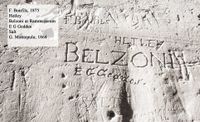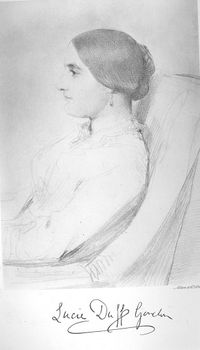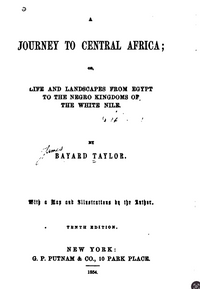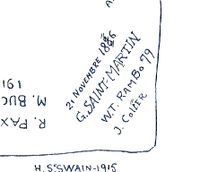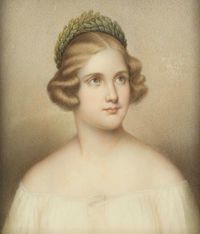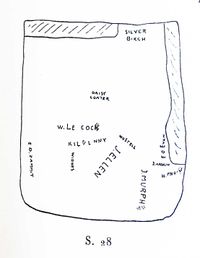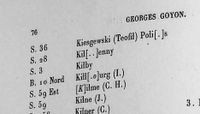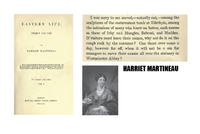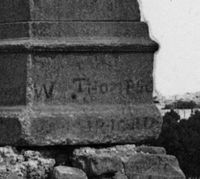Critique, observations and comments by others ...
Travellers noticing graffiti
"The scribbling of names is quite infamous, beautiful paintings are defaced by Tomkins and Hobson" and on Pückler's inscriptions, she finds: "[...] but worst of all Prince Pückler Muskau has engraved his and his Ordenskreuz in huge letters on the naked breast of that august and pathetic giant who sits at Abou Simbel. I wish someone would kick him for his profanity."
Bayard seemed annoyed as he continues his critique while visiting Abu Simble:
"The ridiculous vanity of tourists has not even spared these sublime monuments, and they are covered wherever a hand can reach, with tho names of noble and ignoble snobs. The enthusiastic antiquaries who cleared away the sands have recorded the fact in modest inscriptions, near the door, where they do not offend the eye; and one readily pardons the liberty the writers have taken.
But there are two Germans (whose names I will not mention, since it would help give them the very notoriety they covet), who have carved their names in letters a foot long, on the thigh of one of the statues, and afterwards filled them with black paint. I should like to see them subjected to a merciless bastinado, on the same part of their own bodies. Certainly, to have one of the statues seated on their breasts as a nightmare, every night of their lives, would not be too much punishment for such a desecration."
(Taylor, James Bayard: Journey to Central Africa, New York 1854)
Jenny Lind
Jenny Lind a Swedish opera singer popular around Europe and America in the mid 19th century, never visited Egypt, but maybe a fan of hers left her name on the pyramids. Author Carter Henry Harrison suspects it being Bayard Taylor. But then again Fürst Pückler also was a fan of hers which Harrison might not have known. Harrisson writes:
"My heart was warmed up here in Egypt when seeing the names of some old acquaintance now dead. I felt we were living over again a half forgotten past. I saw ‘Jenny Lind’s’ name upon the pyramid. Did she have it cut, or did some of her lovers do it? I do not know. But for a moment there came from the west, over the dead desert, a trill of perfected harmony which I never heard but once, and will never hear again until an angel song shall come to my ear from white robed ones hovering around the throne of the eternal. I can almost fancy that Bayard Taylor had the name cut. I have a vague recollection of his telling me of it. He almost worshipped the Swedish Nightingale."
Bayard himself complaining about the name in his account, maybe he did this on purpose to distract his readers of not being suspected that he himself was actually leaving graffiti as well.
While in Berlin, Fürst Pückler admired the singer Jenny Lind:
Georges Goyon did not document the name Jenny Lind, maybe it had vanished over time. Possibly he registered it as "S.28 Kil [enny]"
Lady Lucie Duff Gordon
'Sitt el Kebeer,' the great lady, who 'was just and had a heart that loved the Arabs.'
Was an English author and translator known for her Letters from Egypt, 1863–1865 (1865) and Last Letters from Egypt (1875), most of which are addressed to her husband, Alexander Duff-Gordon, and her mother, Sarah Austin. Having moved in prominent literary circles in London, she contracted tuberculosis and travelled in 1861 to South Africa for health reasons. She travelled on to Egypt in 1862 where she settled in Luxor, learnt Arabic, and wrote many letters about Egyptian culture, religion, and customs. Her letters are notable for humour, outrage at the ruling Ottomans, and many personal stories from the people around her.
Amelia Edwards:
“At Luxor the French Consul showed us over the old tumble-down building called ‘The French House’ which, though but a rude structure of palm-timbers and sun-dried clay, built partly against and partly over the Temple of Luxor, has its place in history. For there, in 1829, Champollion and Rosellini lived and worked together during part of their long sojourn at Thebes. There, too, lodged naval officers sent out by the French in 1831 to remove the obelisk which now stands in the Place de la Concorde. And there, writing those charming letters that delight the world, Lady Duff Gordon lingered through the last few winters of her life. (Source: Wikipedia)
James Bayard Taylor
"There is no limit to human silliness, as I have wisely concluded, after seeing Pompey's Pillar dis- figured by "Isaac Jones" (or some equally classic name), in capitals of black paint, a yard long, and finding "Jenny Lind" equally prominent on the topmost stone of the great Pyramid. (Of course, the enthusiastic artist chiselled his own name beside hers) A malletand chisel are often to be found in the outfits of English and American travellers, and of judge from the frequency of certain names, and the pains bestowed upon their inscription, the owners must have spent the most of their time in Upper Egypt, in leaving records of their vulgar vanity."
(Taylor, James Bayard: Journey to Central Africa, New York 1854)
At the Great Pyramid Flaubert observes: "Under the name of Belzoni, and no less large, is that of M. Just de Chasseloup-Laubat" (1800-1847) a French statesman, who had been touring around 1825 Greece, Egypt and Syria. Flaubert continues: "One is irritated by the quantity of imbeciles' names written everywhere: at the top of the Great Pyramid; there's a Buffard, 79, rue Saint-Martin, wallpaper manufacturer, in black letters; an enthusiastic Englishman has written: Jenny Lind; moreover, a pear representing Louis-Philippe (almost all modern names)".
British traveler George Alexander Hoskins, who chronicled his experiences in A Winter in Upper and Lower Egypt 1860-61, regretted inscribing his name on one of the statues at Abu Simbel during a prior trip. Thirty years later, 1863 he admits:
“ […] the mania of writing names on the walls destroy the beautiful uncoloured outlines in one of the chambers. I can easily suppose such travellers would write their names on the frescos of Raphael in the Vatican, if there were no custody to prevent them. With the thoughtlessness of a young traveller, I confess, on my first visit to the Nile, (1832-1833) I wrote my name on one of the colossal statues in the interior of Aboo Simbel, and was greatly annoyed at what I had done when, elsewhere, and especially in this tomb, by the light of my illumination, I saw the destructive effect of an accumulation of such offences, and was really relieved to find on my last visit to the temple that time and decay had completely effaced my only offence of that description. Those who really care for art, and do not wish to have a similar crime on their consciences, would do well to record their visit to the Nile on the rock at the second cataract, on the top of the pyramids, or on such places where it may be done with impunity.”
Quoting once more Felicis Fabri from the 1440s, who suggested after noticing the inscriptions along his travels: "It would be tolerable and useful for something, that noble names with shields and arms in inns and taverns, in headquarters and courts, in towers, camps, gates and walls, in the places of theaters, in the fields and in tournaments and tournaments they would paint and write in the streets and in other secular places, but to do this in churches and holy places is unjust and unreasonable and criminal."
This was also, just 400+ years later, suggested by Harriet Martineau
"[...] here is a host of names carved on the accessible side of Abooseer. We looked with interest on Belzoni's and some few others. We cut ours with a nail and hammer. Here, and here only, I left my name. On this wild rock, and at the limit of our range of travel, it seemed, not only natural, but right to some who may come after us. Our names will not be found in any temple or tomb. If we ever do such a thing, may our names be publicly held up to shame, as I am disposed to publish those of the carvers and scribblers who have forfeited their right to privacy by inscribing their names where they can never be effaced ! "
Martineau, Vo. I, p. 145
"Our names will not be found in any temple or tomb. If we ever do such a thing, may our names be publicly held up to shame..."
Gustave Flaubert
W. Thompson. Unfortunately no information on this traveller, though he did get some fame, as he was noticed by others visitors. Such as French poet Gustave Flaubert, who while traveling along with photographer Maxime DuCammps in 1849-50 along the Nile, seemed annoyed on some of the inscriptions he had found on the ancient monuments.
Especially several graffiti left by Carlo Vidua annoyed Flaubert:
"Nous lisons dans les temples les noms des voyageurs, cela nous parait bien grêle et bien vain. Nous n'avons mis les notres null pas. Il y en a qui ont du demander trois jours à être gravés, tant c'est polen. dément entaillé dans la pierre. Quelques-uns se retrouvent partout aver une constance de bêtise sublime. Il y a un nommé Vidua surtout qui no nous quitte pas... "
"We read the names of the travellers in the temples, and it seems to us that they are hapless and vain. We haven't put ours on mill pas. Some of them must have taken three days to engrave, so polite is it to carve them into the stone. Some of them are to be found everywhere with a sublime constancy of stupidity. There's one called Vidua in particular who won't leave us... "
Vidua left ca. 19 graffiti, two of them have been partly scratched out. Kiosk Qertassi, Karnak, Bêt el Ouali, Dendour, de Gerf Hussein, Dakké, Abou-Simbel, Faras. d'Abousir , Dakka, Kalabcha, Bêt el Ouali.
At Abu Simbel Vidua, which he mentioned in a letter, had his Greek dragoman Leonardo place a graffiti.
"Sur un des colosses de dehors, LEoNARDO mon drogman Grec me grava celle inscription: CARLo VIDUA ITALIANO QUI VENNE DALLA LAPONIA. 1820"
